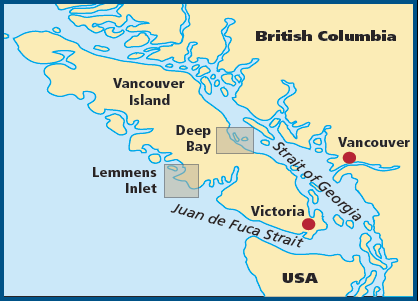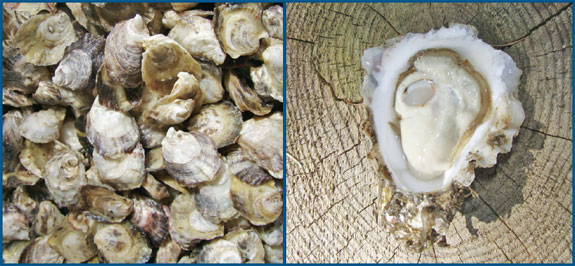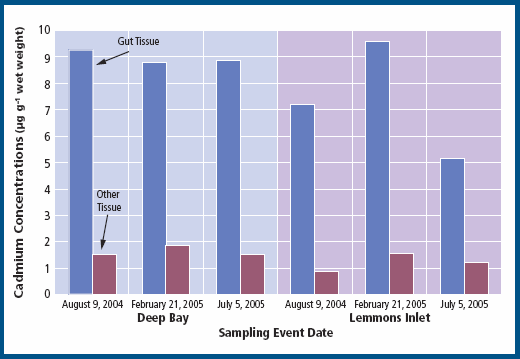Aquaculture Collaborative Research and Development Program (ACRDP) Fact Sheet
Issue 7 - May 2010
Summary
British Columbia (BC) shellfish growers are interested in expanding their sales in international markets, which would increase demand for their products and allow the industry to further mature. However, in the past, concentrations of the toxic metal cadmium (Cd) in BC Pacific oysters (Crassostrea gigas) (at times exceeding the importing country's standards) have limited this opportunity. The allowable limit of Cd in bivalve molluscs for export varies between 1.0 and 3.7 μg g-1 wet weight, depending on the importing country. The presence of Cd in shellfish poses a significant challenge to the BC shellfish export trade, as certain human activities and natural coastal geology affect Cd levels in the environment and, ultimately, the animals. This research sought to determine the variables that affect the accumulation of Cd in BC cultured oysters. The results of the project will help growers understand, and potentially mitigate, high levels of Cd in their shellfish, thereby contributing to the long-term sustainability of oyster culture in British Columbia.
Introduction
Cadmium (Cd) is a naturally occurring and relatively abundant element. Possible sources of Cd in the environment include the gradual erosion of rocks and soils as well as various human activities (e.g., mining, fertilizers, logging, and improper disposal of industrial and residential wastes). There is no clear correlation, however, between the location of these various Cd sources and high Cd concentrations in oysters.
To obtain a permit for export to certain international markets, BC shellfish growers must demonstrate that their products consistently contain less than the allowable limits for Cd concentration (1.0 – 3.7 μg g-1 wet weight, depending on the market). However, periodic testing for Cd by BC shellfish growers has produced highly variable and unpredictable results, with some batches of Pacific oysters (Crassostrea gigas) being above the allowable limits established by certain international markets.
Oysters may bioaccumulate metals from seawater due to their high filtration rates. Cd is likely to be taken up incidentally, either in particulate form (suspended mineral and organic particles or phytoplankton) or dissolved form (simple hydrated metal ions). Levels of bioaccumulation of Cd in oysters can be influenced by environmental conditions (e.g., salinity and temperature), chemical and physical characteristics of the metal, and the growth and physiology of the oysters. Food (i.e., phytoplankton and other organic particles) is thought to be one of the most likely sources of Cd in oysters.

Figure 1
Location of the project sampling sites: Deep Bay and Lemmens Inlet.
A research project was conducted with the aim of:
- determining the natural seasonal variability of Cd in oysters and
- investigating the role of dissolved and particulate forms of Cd in the ultimate accumulation of this metal in oysters over an annual cycle.
Methods
The project was conducted during 2004 and 2005. Two study sites were chosen for anticipated variability in environmental conditions: Deep Bay (Baynes Sound, east coast Vancouver Island) and Lemmens Inlet (Clayoquot Sound, west coast Vancouver Island) (Figure 1).
Seawater samples were collected at 5 m depth and oysters (Crassostrea gigas) (Figure 2) at 2 – 5 m depth at both sampling sites at various times over a one-year period: biweekly during the summer and monthly during the winter. Water temperature and salinity were recorded at each sampling interval. Seawater samples were analyzed for both particulate and dissolved Cd levels. After collection, oysters were measured (length and weight), shucked, and the tissues analyzed for Cd concentration. At three sampling times throughout the year, tissue from sampled oysters was segregated into gut and non-gut components to determine Cd distribution in the soft tissues.

Figure 2
Pacific oyster (Crassostrea gigas): Left – external view; Right - interior view, showing the oyster on the half shell. (Images are the property of David McCallum).

Figure 3
Seasonal variability of water temperature and mean Cd concentrations in oysters at (a) Deep Bay and (b) Lemmens Inlet.
Results
Site and Seasonal Variability of Cd in Oysters
Oysters from Deep Bay contained higher Cd levels (means ranging from 1.17 to 3.57 μg g-1 wet weight) than those from Lemmens Inlet (means ranging from 1.40 to 2.47 μg g-1 wet weight). Data suggest a statistically significant seasonal trend with the highest Cd concentrations in overall oyster tissues occurring during the end of winter and early spring when the corresponding water temperatures were lowest (Figure 3). Lower Cd concentration in oysters was seen during the summer and fall, when the water temperatures were highest. This inverse (or negative) correlation between temperature and Cd in oysters was statistically significant at both sites (Table 1) and may have been driven by a number of factors. Winter upwelling may bring colder deeper water, rich in dissolved Cd, to the surface. As well, during the colder seasons, phytoplankton are much less abundant and therefore the uptake of dissolved Cd by these algae is minimal, resulting in higher dissolved Cd in the water and a greater accumulation of this form of Cd by the oysters. In addition, higher temperatures may lead to increased oyster growth rates and a resultant stabilization or decrease of Cd concentration in oyster tissues.
Cd Concentrations in Various Oyster Tissues
Statistically significant differences between Cd concentrations in the gut and other non-gut tissues were seen at both sites. Cd was highly concentrated in the gut (means between 6.10 and 9.69 μg g-1 wet weight for both sites) while Cd concentrations were significantly lower in tissues other than the gut (means between 0.94 and 1.97 μg g-1 wet weight for both sites) (Figure 4).
Table 1.
| Deep Bay | Lemmens Inlet | Combined Dataset | ||||
|---|---|---|---|---|---|---|
| Cd in Oysters | Dissolved Cd | Cd in Oysters | Dissolved Cd | Cd in Oysters | Dissolved Cd | |
| Dissolved Cd | Positive Significant | / | Not Significant | / | Positive Significant | / |
| Particulate Cd | Not Significant | Negative Significant | Negative Significant | Not Significant | Negative Significant | Negative Significant |
| Oyster Tissue Mass | Not Significant | Not Significant | Negative Significant | Not Significant | Negative Significant | Negative Significant |
| Water Temperature | Negative Significant | Negative Significant | Negative Significant | Positive Significant | Negative Significant | Not Significant |
Role of Dissolved Versus Particulate Cd
Although significantly more Cd was found in the gut than in all other oyster tissues, particulate Cd was not positively correlated with oyster Cd levels, suggesting that particulate Cd accumulates in oysters in an easily mobilized form, which can be readily purged by the oysters. It was, in fact, seen that particulate Cd was significantly negatively correlated with oyster Cd levels at Lemmens Inlet (and with the combined data set) (Table 1), meaning that as the level of particulate Cd in the water column increased, the amount of Cd found in the oyster tissues actually decreased. This relationship may be due to the presence of phytoplankton which can: (1) take up dissolved Cd and make it less available to the oysters and (2) increased oyster growth rates leading to increased tissue mass and lower tissue Cd concentrations.

Figure 4
Mean Cd concentrations in the gut and in all other tissues in oysters from Deep Bay and Lemmens Inlet during three sampling events.
Dissolved Cd was significantly positively correlated with oyster Cd at Deep Bay (and with combined data set), but not at Lemmens Inlet. This may have been due to significantly lower dissolved Cd levels at Lemmens Inlet (0.21 – 0.46 nM) than at Deep Bay (0.45 – 0.81 nM) and the overall lower variability in oyster Cd at Lemmens Inlet.
Conclusions
This study showed that dissolved Cd was the main source of Cd in cultured Pacific oysters and that, within the oysters, Cd was primarily concentrated in the gut tissues. Particulate matter was not found to be a significant source of Cd in oysters and was actually negatively correlated (likely due to the uptake of dissolved Cd by phytoplankton and the growth effect of phytoplankton on oyster tissue mass). Cadmium in oyster tissues was found to be inversely correlated with temperature.
While the motivation for this study was to provide shellfish growers with management options for the apparent high levels of Cd in their animals, the determined primary pathway, dissolved Cd, is not easily controlled. However, if the potential exists for niche market sales at times of low Cd concentrations, options exist for choosing sites with relatively low dissolved Cd levels and harvesting during the spring and summer months when Cd concentrations in oysters are at their lowest.
This ACRDP project (P-04-04-002) was a collaborative effort among Fisheries and Oceans Canada (DFO Science), the University of British Columbia, and the British Columbia Shellfish Growers' Association. The lead scientist on this project, Dr. Chris Pearce, can be contacted at Chris.Pearce@dfo-mpo.gc.ca.
Further information on this project is available in the following publication: Lekhi P, D Cassis, CM Pearce, N Ebell, MT Maldonado, KJ Orians (2008) Role of dissolved and particulate cadmium in the accumulation of cadmium in cultured oysters (Crassostrea gigas). Sci Total Environ 393: 309-325.
For further information on this and other ACRDP projects, visit: /aquaculture/acrdp-pcrda/index-eng.htm.
Published by:
Aquaculture Science Branch
Fisheries and Oceans Canada
Ottawa, Ontario K1A 0E6
©Her Majesty the Queen in Right of Canada 2010
ISSN 1919-6806 (Print),
ISSN 1919-6814 (Online)
DFO/2008-1493
- Date modified: